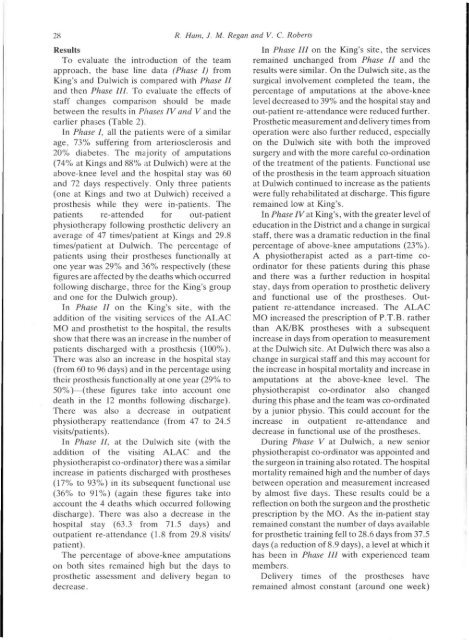View Complete Issue PDF
View Complete Issue PDF
View Complete Issue PDF
You also want an ePaper? Increase the reach of your titles
YUMPU automatically turns print PDFs into web optimized ePapers that Google loves.
28 R Ham, J M. Regan and V. C. Roberts<br />
Results<br />
To evaluate the introduction of the team<br />
approach, the base line data (Phase I) from<br />
King's and Dulwich is compared with Phase II<br />
and then Phase III. To evaluate the effects of<br />
staff changes comparison should be made<br />
between the results in Phases IV and V and the<br />
earlier phases (Table 2).<br />
In Phase I, all the patients were of a similar<br />
age, 73% suffering from arteriosclerosis and<br />
20% diabetes. The majority of amputations<br />
(74% at Kings and 88% at Dulwich) were at the<br />
above-knee level and the hospital stay was 60<br />
and 72 days respectively. Only three patients<br />
(one at Kings and two at Dulwich) received a<br />
prosthesis while they were in-patients. The<br />
patients re-attended for out-patient<br />
physiotherapy following prosthetic delivery an<br />
average of 47 times/patient at Kings and 29.8<br />
times/patient at Dulwich. The percentage of<br />
patients using their prostheses functionally at<br />
one year was 29% and 36% respectively (these<br />
figures are affected by the deaths which occurred<br />
following discharge, three for the King's group<br />
and one for the Dulwich group).<br />
In Phase II on the King's site, with the<br />
addition of the visiting services of the ALAC<br />
MO and prosthetist to the hospital, the results<br />
show that there was an increase in the number of<br />
patients discharged with a prosthesis (100%).<br />
There was also an increase in the hospital stay<br />
(from 60 to 96 days) and in the percentage using<br />
their prosthesis functionally at one year (29% to<br />
50%)—(these figures take into account one<br />
death in the 12 months following discharge).<br />
There was also a decrease in outpatient<br />
physiotherapy reattendance (from 47 to 24.5<br />
visits/patients).<br />
In Phase II, at the Dulwich site (with the<br />
addition of the visiting ALAC and the<br />
physiotherapist co-ordinator) there was a similar<br />
increase in patients discharged with prostheses<br />
(17% to 93%) in its subsequent functional use<br />
(36% to 91%) (again these figures take into<br />
account the 4 deaths which occurred following<br />
discharge). There was also a decrease in the<br />
hospital stay (63.3 from 71.5 days) and<br />
outpatient re-attendance (1.8 from 29.8 visits/<br />
patient).<br />
The percentage of above-knee amputations<br />
on both sites remained high but the days to<br />
prosthetic assessment and delivery began to<br />
decrease.<br />
In Phase III on the King's site, the services<br />
remained unchanged from Phase II and the<br />
results were similar. On the Dulwich site, as the<br />
surgical involvement completed the team, the<br />
percentage of amputations at the above-knee<br />
level decreased to 39% and the hospital stay and<br />
out-patient re-attendance were reduced further.<br />
Prosthetic measurement and delivery times from<br />
operation were also further reduced, especially<br />
on the Dulwich site with both the improved<br />
surgery and with the more careful co-ordination<br />
of the treatment of the patients. Functional use<br />
of the prosthesis in the team approach situation<br />
at Dulwich continued to increase as the patients<br />
were fully rehabilitated at discharge. This figure<br />
remained low at King's.<br />
In Phase IV at King's, with the greater level of<br />
education in the District and a change in surgical<br />
staff, there was a dramatic reduction in the final<br />
percentage of above-knee amputations (23%).<br />
A physiotherapist acted as a part-time coordinator<br />
for these patients during this phase<br />
and there was a further reduction in hospital<br />
stay, days from operation to prosthetic delivery<br />
and functional use of the prostheses. Outpatient<br />
re-attendance increased. The ALAC<br />
MO increased the prescription of P.T.B, rather<br />
than AK/BK prostheses with a subsequent<br />
increase in days from operation to measurement<br />
at the Dulwich site. At Dulwich there was also a<br />
change in surgical staff and this may account for<br />
the increase in hospital mortality and increase in<br />
amputations at the above-knee level. The<br />
physiotherapist co-ordinator also changed<br />
during this phase and the team was co-ordinated<br />
by a junior physio. This could account for the<br />
increase in outpatient re-attendance and<br />
decrease in functional use of the prostheses.<br />
During Phase V at Dulwich, a new senior<br />
physiotherapist co-ordinator was appointed and<br />
the surgeon in training also rotated. The hospital<br />
mortality remained high and the number of days<br />
between operation and measurement increased<br />
by almost five days. These results could be a<br />
reflection on both the surgeon and the prosthetic<br />
prescription by the MO. As the in-patient stay<br />
remained constant the number of days available<br />
for prosthetic training fell to 28.6 days from 37.5<br />
days (a reduction of 8.9 days), a level at which it<br />
has been in Phase III with experienced team<br />
members.<br />
Delivery times of the prostheses have<br />
remained almost constant (around one week)
















